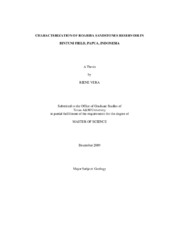| dc.description.abstract | Bintuni Field has two Middle Jurassic gas reservoirs, Upper and Lower Roabiba
Sandstone reservoirs, with the estimated reserve from eight appraisal drilled wells of
6.08 tcf. The field has not been producing commercially. The main gas reservoir is the
Upper Roabiba Sandstone. It was deposited in a tidal-dominated shoreface delta and
consists of a moderately sorted, fine to medium grain, quartzarenite with average
porosity of 12% and average permeability of 250 md. Lower Roabiba Sandstone was
deposited in estuarine channel and marsh and consists of lower fine to lower coarse
grained quartzarenites with average porosity of 12% and permeability 215 md.
This study is considered necessary since the field is considered to be a giant field
and there are a limited number of studies on the Roabiba Sandstones reservoir
specifically in Bintuni Field that have been published. The purpose of this study was to
develop geological and petrophysical analysis that will identify reservoir quality and
distribution of best, intermediate, and poor reservoir zones by characterizing distribution
of porosity-permeability values in lithofacies and mercury injection capillary pressure.
The methods to characterize the reservoir included core-based lithofacies
determination, well logs analysis, and mercury injection capillary pressure analysis. As a
result from core descriptions, three main units of lithofacies could be identified.
Lithofacies massive sandstones (ms), slightly bioturbated sandstones (sb1), and crosslaminated
sandstones (xls) have the highest average permeability (>100 md) and
porosity (>10%). Petrophysical properties from core data show that porosity varies only
slightly regardless of lithofacies characteristic whereas permeability variations are
greater and correspond closely with the lithofacies.
When grouped according to the dominant pore throat dimension, distinct
collections or grouping of rocks and their associated lithofacies were observed. Winland
plot was engaged to do clustering of rock types since Winland R35 pore port sizes
represent "cut off values" for good and bad flow unit quality. The analyses of porositypermeability
plots were confirmed with the Winland plot that the best reservoir rock
(rock type 1) consists of lithofacies ms, xls, and sb1. From this development, four
petrophysical rock types were defined and characterized. Rock type 1 (the best reservoir
rock) consists of lithofacies ms, xls, and sb1. Therefore, associated lithofacies in rock
type 1 may be used as a pore-proxy rock property for the determination of best reservoir
rock and corresponding flow units at the reservoir scale. | en |


